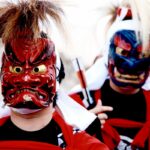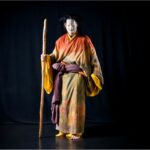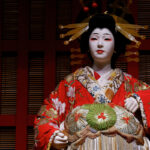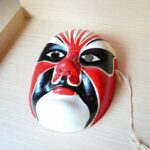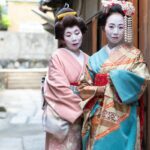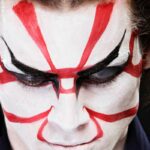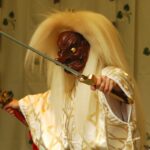Kabuki is an art form that’s truly one-of-a-kind. A performance rich in showmanship, featuring elaborate costumes, impressive sets, eye-catching makeup and exaggerated actions, every kabuki play is steeped in drama and a storied history. It’s an art form that’s completely unique to Japan.
A kabuki performance tells a story through the actors’ highly stylized movements. Their universal meaning is of particular importance, since old-fashioned Japanese is typically used for narration, and even Japanese people find it difficult to understand. Nevertheless, kabuki has persevered through the ages and remains a powerful art form even today, in the digital age (see also ‘Who Created Kabuki?‘).
Read on to discover the unique history of kabuki, and how you can witness a performance yourself during your journey to Japan.
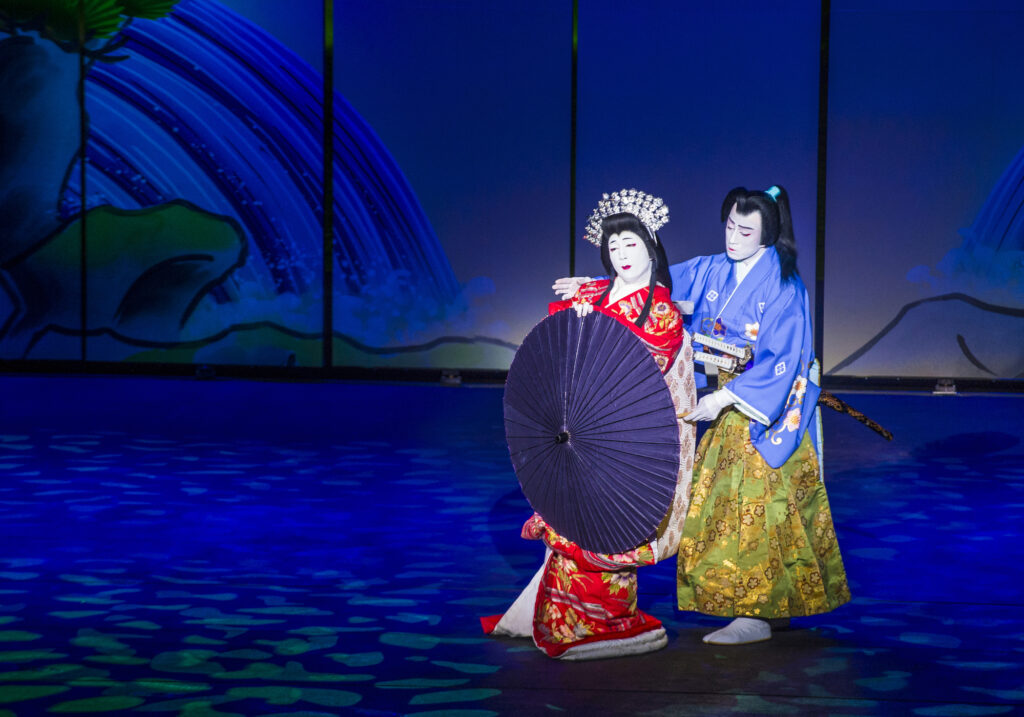
The history of kabuki
Kabuki has a long, unique history dating back to the 1600s. The art form is said to have been created by a Shinto priestess named Izumo no Okuni, who began performing in the early 1600s at various locations around Kyoto. She formed an all-female troupe of performers who acted, sang and danced at shrines and in the dry riverbed of the Kamo River. Portraying both male and female characters, the troupe performed comedic plays about everyday topics. Plays were often witty and suggestive, and performances quickly became popular with the general public. Soon, troupes formed in cities like Edo (modern-day Tokyo), and Okuni herself performed in front of the Imperial Court.
Soon, kabuki became common in red-light districts across the country, and they became linked with prostitution. Kabuki caused a moral panic that eventually led to the prohibition of women actors in 1629. Adult men took up the mantle, playing the role of both male and female (read more about female characters played by men here).
Traditionally, kabuki was seen as strange and avant-garde, a bizarre entertainment for commoners. Performances were often seen as lewd and crude, and spectators were often rowdy. It took decades for kabuki to gain a more respectable reputation, and by the 18th Century, the performance was seen for what it is today—a true art form.
In the 18th Century, kabuki performances became more formalized and structured. Troupes established recurring character types, all while continuing the tradition of strange, over-the-top movements and visuals. Today, kabuki is recognized as one of Japan’s three national performance arts, alongside noh and bunraku (learn the difference between them all here).
Kabuki as a medium for storytelling
Kabuki plays tell a variety of stories, with most themes focusing on the clash between human emotions and morality (see also ‘An In-Depth Exploration Of The 3 Types Of Kabuki Plays‘). Plays generally fit into one of three categories—jidaimono, or early historical and legendary stories; sewamono, or contemporary tales set after 1600 and shosagoto, or dance dramas.
Common stories highlight Japanese moral ideals, and they often rely heavily on themes from Shino, Buddhism and Confucianism. They emphasize values like respect for one’s elders and devotion to community, but there are often cautionary tales. Some plays showcase how emotions like love and revenge can get in the way of one’s duties, creating a central conflict. These are often tragedies, showing the audience the dangers of certain emotions.
Kabuki actors use movement to tell stories, using choreographed dance-like movements to convey emotion. From roppo movements that simulate walking or running to tachimawari poses that signify combat, you’ll witness several distinct performance techniques in every kabuki performance. Many of these dances are paired with perfectly-timed music to reinforce concepts and communicate emotions to the audience.
Kabuki dramas sometimes include a teaching element, designed to provoke thoughts and feelings in the audience. Overall, the main focus of kabuki is on bringing a visual spectacle to life. As you watch a performance, you’ll notice that elaborate costumes and supernatural events take precedence over reality and consistency. It’s truly a display to behold.
The significance of sets and costumes in kabuki
Kabuki performances often feature elaborate sets and costumes that tell a story. Stage decorations are extravagant, often including complex machines like trap doors, moving lifts and curtains. These machines allow the performers and backgrounds to undergo awe-inspiring transfigurations—actors may suddenly disappear through a trap door, only to reappear into the audience; and apparitions can be suspended in midair.
In terms of costumery, kabuki performances are often set in the past, so performers wear kimono. You’ll see everything from practical and subdued kimono to elaborate, decorative kimono. Kabuki actors practice tirelessly to move and manipulate their heavy costumes, which is no small feat. All costumes and wigs are handmade by skilled craftspeople, and some even include ornately weaved gold and silver threads.
Typical kabuki conventions
Aside from the elaborate sets and costumery, there are other typical kabuki conventions that make the performance what it is. Traditionally, kabuki was only performed by women and was popular with common people. During the Edo Period, though, restrictions from the shogun forbade women from participating. To present day, only men perform kabuki, and some actors specialize in playing female roles, or onnagata.
Other than the actors on stage, you might notice assistance dressed in black. Called kurogo, these assistance hand the actors props or assist them in various ways. Don’t pay too much attention to kurogo—they’re supposed to be regarded as non-existent.
During a kabuki performance, you might be surprised to hear spectators shouting to the actors from the audience. This isn’t a sign of disrespect. All kabuki actors have a stage name, or yago, that’s closely associated with the theater troop they belong to. It’s common for the audience to shout actors’ names during appropriate timing as a show of support and pride.
Finally, no discussion of kabuki is complete without mentioning makeup. Kabuki makeup is immediately recognizable and is based on a character’s traits. Each actor’s face is covered with white paint, or oshiroi, to make the character more visible and dramatic. Colored lines are added to enhance an actor’s features and designate their character. Blue lines signify evil or sadness, while red lines symbolize anger or passion. Patterns are also important and are meant to signify a character’s gender.
Ghosts and demons have the most dramatic makeup, meant to strike awe and fear into the audience. Makeup is so central to kabuki performances that actors apply their own makeup to get into character. In some situations, kabuki masks are used rather than makeup, but this convention is more common in noh theater.
Where to see modern-day kabuki
In the past, the Japanese enjoyed the art of kabuki in select venues in cities like Edo (modern-day Tokyo), Osaka and Kyoto. Rural towns also had their own versions of kabuki. Today, locals and tourists alike can relax in Western-style seats and enjoy kabuki in theaters across the country.
A day’s performance is typically divided into two or three sections: one in early afternoon, with more in the evening. Each segment is further divided into acts. You can buy tickets for each segment, but in some cases, you’ll find tickets sold per act. Expect to pay around 2,000 yen per act, or around 25,000 for an entire segment, depending on the seats you pick. Here are some of the most popular venues where you can catch a great kabuki performance:
- Kabukiza Theater: In Tokyo’s ritzy Ginza district, Kabukiza Theater is the most accessible venue for foreign tourists. The venue offers single-act tickets sold day-of at the ticket window, or you can buy regular performance tickets online.
- Minamiza Theater: If you want to see a kabuki performance in Kyoto, book tickets at the legendary Minamiza Theater. Located in the Gion district, this venue offers several runs of shows per year, each lasting between three to four weeks. Depending on the performance, English information devices may be available.
- Shochikuza Theater: In Osaka, the Shochikuza Theater offers a few runs of shows each year, lasting about one month. Located in the Dotombori district near Namba Station, the venue is easily accessible, but it doesn’t offer English information devices.
Want to see what a traditional kabuki theater was like? There are several historical theaters across Japan that no longer host performances, but let you get a closer look at the feel and structure of a traditional kabuki theater. Visit Kanamaruza Theater in Kotohira or Uchikoza Theater in Uchiko and explore the richness of traditional Japanese kabuki culture (see also ‘Kabuki: A Complete Guide To The Japanese Theater Experience‘).
Kabuki theater is a UNESCO Intangible Cultural Heritage
UNESCO, or the United Nations Educational, Scientific and Cultural Organization, is well-known for protecting heritage sites around the world, but they also protect intangible cultural treasures, including kabuki. In November 2005, the organization designated kabuki as a Masterpiece of the Oral and Intangible Heritage of Humanity, highlighting its status as a world treasure. When you witness a kabuki performance, you’re taking in an event with immense cultural significance—it’s truly a once-in-a-lifetime experience.
Enjoy the timeless art of kabuki theater
No visit to Japan is complete without witnessing a performance of authentic kabuki theater. This art form is uniquely Japanese, and attending a play is a glimpse into the country’s special historical traditions. Plan your visit to Japan, book your seats at the nearest kabuki theater and enjoy a once-in-a-lifetime experience you’ll remember forever (find out the major differences between kabuki and western theater here)!
- How Much Money Can You Make Teaching English in Japan? - December 12, 2022
- The Best Places to Teach English in Japan - December 9, 2022
- The Best Credentials for Teaching English in Japan - December 8, 2022

